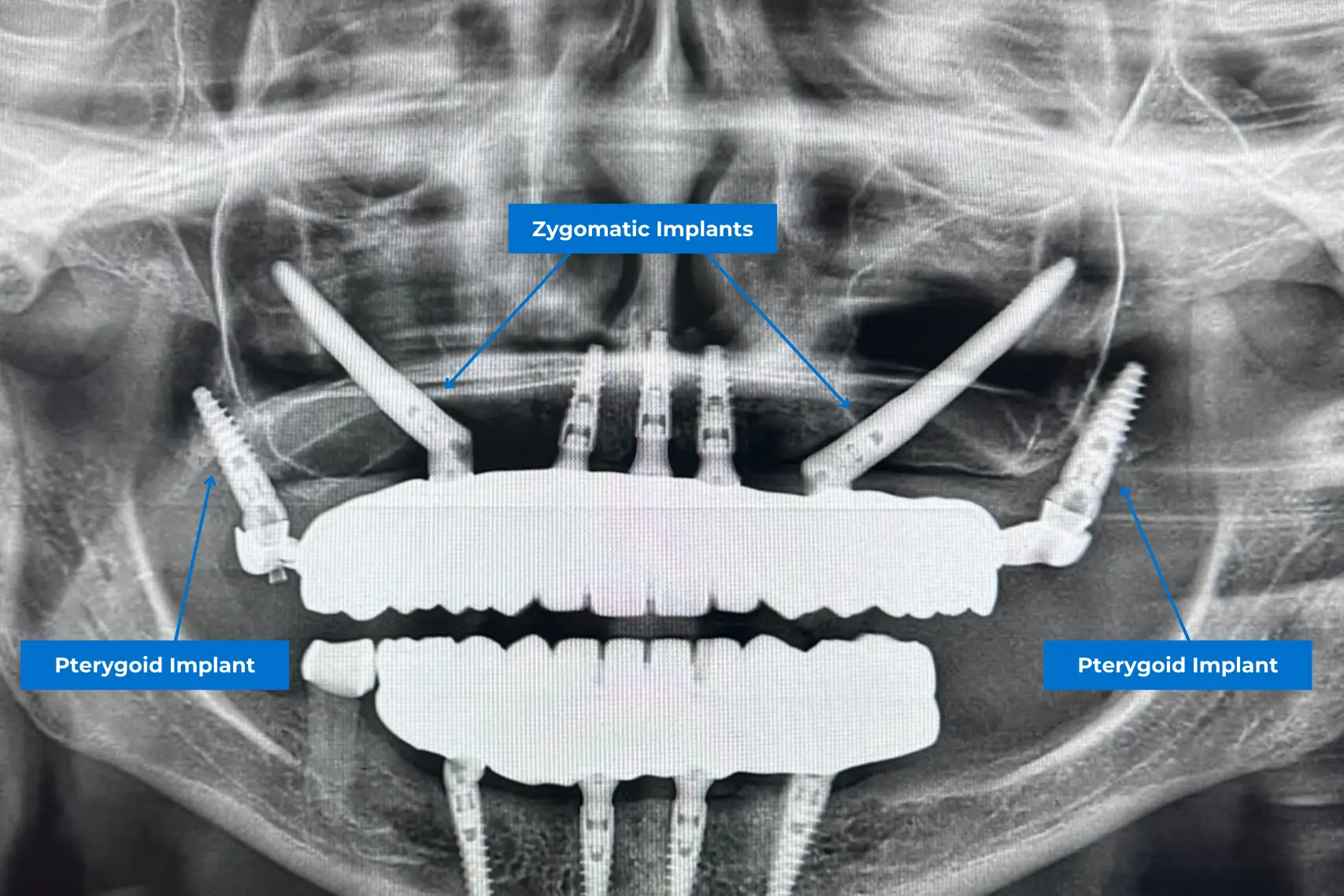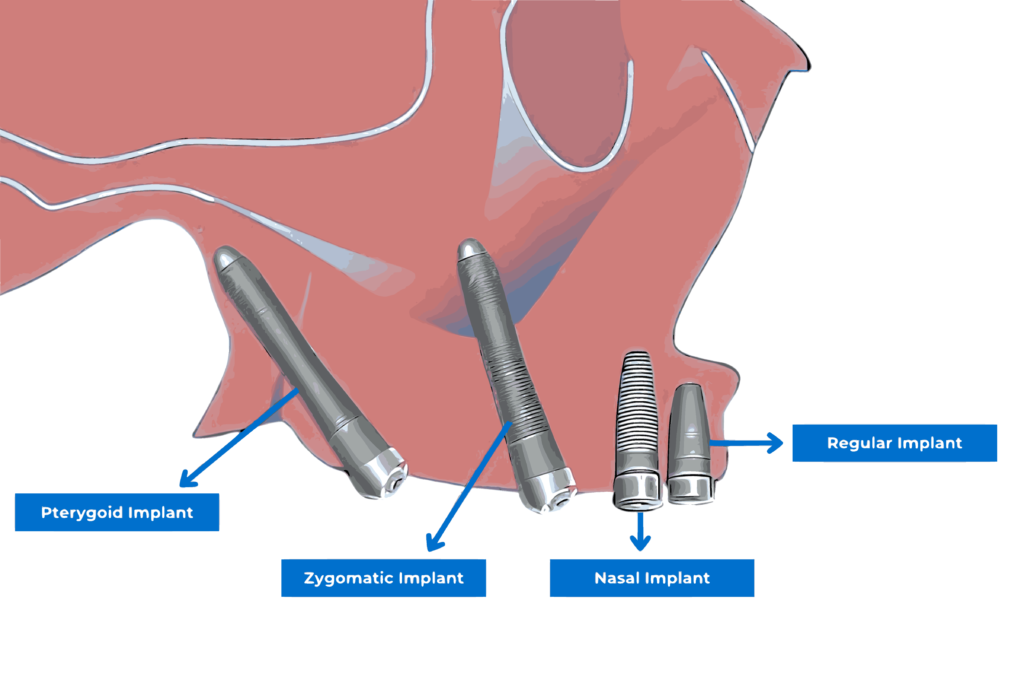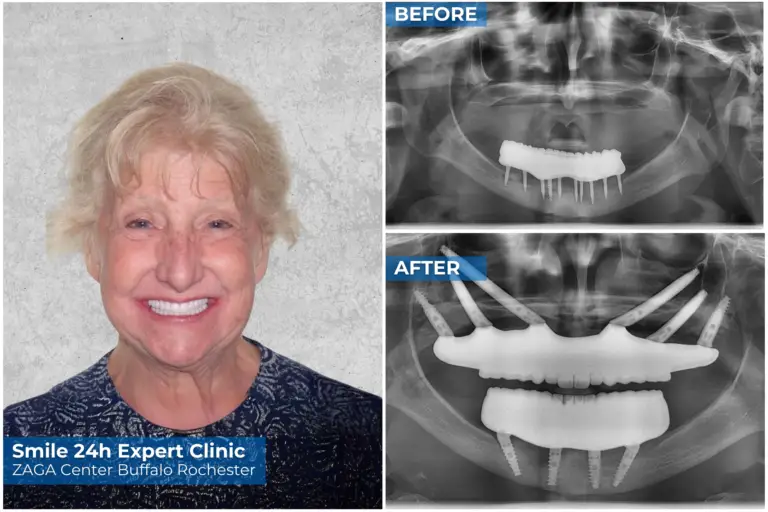Pterygoid Dental Implants: A Comprehensive Guide
Pterygoid implants, also known as pterygoid dental implants, are an advanced solution for patients with severe bone loss in the upper jawbone. This type of implant offers an alternative to traditional implants that may require bone grafting or sinus augmentation. They are particularly effective for rehabilitating patients with missing teeth in the posterior maxilla (upper jaw), where conventional dental implants may not be feasible due to insufficient bone.
If you’ve been curious about what pterygoid implants are, how they work, and why, on some occasions, they are the last resort for patients with maxillary atrophy to have fixed teeth, keep reading to discover everything you need to know by the hand of the Certified ZAGA Doctor Adi Lorean, director of the exclusive ZAGA Center Tel Aviv!
What Are Pterygoid Implants?
Pterygoid implants are specialized dental implants placed in the pterygoid plate, part of the sphenoid bone at the back of the upper jaw. This region offers dense, stable bone that is resistant to the atrophy often seen in the upper jaw following tooth loss. Pterygoid implants are longer than conventional implants, typically ranging between 15 to 20 millimeters, and their placement is at an angle to utilize the stronger bone in the pterygomaxillary region.
These implants are an excellent alternative for patients who have lost significant bone mass in the upper jaw and are not suitable candidates for traditional implants due to the lack of sufficient bone volume.
Why Are Pterygoid Implants Necessary?
Pterygoid implants offer several significant benefits over traditional implant placement techniques, especially in cases where bone loss presents a challenge. Here are some reasons why they are essential:
- Avoiding Additional Surgical Procedures: Pterygoid implants eliminate the need for sinus lifts or bone grafts, which are typically required when there is insufficient bone in the upper jaw. This reduces the complexity, risks, and cost of the procedure.
- Immediate Functionality: In many cases, pterygoid implant placement allows for immediate loading, meaning patients can receive a functional set of teeth the same day as the surgery. This dramatically improves patient satisfaction, as they can regain normal function and aesthetics immediately.
- Long-term Stability: These implants provide long-lasting stability due to their anchorage in dense bone. This minimizes the risk of failure and ensures the durability of the prosthetics.
- Reduced Risk of Sinus Complications: Unlike conventional implants that are placed near or in the sinus cavity, pterygoid implants are positioned behind the maxillary sinus, reducing the risk of sinus perforation and other complications.
When Should You Consider Pterygoid Implants?

Pterygoid implants are most appropriate for patients experiencing significant bone loss in the upper jaw, particularly in the posterior region. It is important to understand that pterygoid implants are always used as a complement or support to zygomatic implants or other types of implants in full-mouth rehabilitations. Pterygoid implants are rarely, if ever, used in isolation to carry out full-mouth rehabilitations. Candidates for pterygoid implants typically include:
- Patients with maxillary atrophy, where the bone is insufficient for traditional implants.
- Those unsuitable for sinus lifts or bone grafting due to medical conditions or preference.
- Individuals seeking a permanent, non-removable solution to upper jaw tooth loss.
- Patients looking for immediate loading solutions such as the All-on-4 approach, which involves placing teeth in a single day.
How Are Pterygoid Implants Placed?
The placement of pterygoid implants is a highly specialized procedure that requires careful planning and precise execution. Here’s a step-by-step breakdown of how the procedure is typically performed:
- Initial Evaluation: A thorough evaluation, including clinical examination and 3D imaging, is done to assess the bone volume and plan the implant placement.
- Surgical Procedure: The procedure will be performed under local or general anesthesia, depending on the case. Once you are sedated, the oral surgeon will place the pterygoid implants anchored to the sphenoid bone, located at the base of the skull, behind the eyes and above the throat. We could say they are anchored in the back of the upper jaw, near the area where wisdom teeth are located.
- Loading the Implants: In many cases, the loading of pterygoid implants is immediate, allowing for the attachment of a temporary dental prosthesis on the same day. Once the osseointegration process is complete and the implant is fully stable, the definitive prosthesis will be loaded.
- Post-Operative Care: Patients receive advice to follow specific care instructions to ensure proper healing and osseointegration.
By Whom Are Pterygoid Implants Placed?

"Pterygoid implants are always a complementary support to zygomatic implants or other types of implants in full-mouth rehabilitations. They are virtually never employed in isolation to achieve a complete oral rehabilitation."
Dr. Adi Lorian, Smile24h Expert Doctor in Tel Aviv, Israel
Pterygoid implants require advanced surgical expertise, as they involve placement in an anatomically complex area. Only experienced implantologists or oral surgeons with specialized training in pterygoid implants placement should perform this procedure. It is essential to consult a dentist who has extensive experience with this technique to minimize risks and ensure optimal results.
At Smile24h, we always recommend choosing a Certified ZAGA Center for your advanced dental implantology treatments. Certified ZAGA Doctors are globally recognized experts in the field of dental implantology and complex dental restoration treatments, always working aligned with the ZAGA Philosophy and the ZAGA Approach to surgery, which focus on minimally-invasive techniques and a “patient-first” approach. With this, undergoing treatment at any ZAGA Center in the world ensures excellent outcomes that are aligned with your needs and expectations and from the caring and expert hands of a team of professionals.
Pterygoid Implants vs. Zygomatic Implants
While both pterygoid implants and zygomatic implants are used for cases of severe bone loss in the upper jaw, there are some key differences between the two:
- Pterygoid implants are placed in the pterygoid plate at the back of the upper jaw, while zygomatic implants are anchored in the zygoma (cheekbone).
- Zygomatic implants are longer, typically ranging from 30 to 55 millimeters, whereas pterygoid implants are generally 15 to 20 millimeters long.
Costs of Pterygoid Implants
The cost of pterygoid implants can vary depending on the location, the complexity of the case, and the specific clinic. On average, the price for a single pterygoid implant can range between £3,000 to £3,500 ($3,700 to $4,300). Some clinics offer financing options to make the procedure more affordable, with monthly payments ranging from £250 to £300 over a 12- to 24-month period.
Take note that these prices can widely vary depending on the location of the clinic, the type of treatment you are undergoing and your concrete needs. For that reason, if you want to receive a custom quote for your concrete case.
Don’t hesitate to contact us to help you find the clinic that suits you best!
Conclusion
Pterygoid implants provide an innovative solution for patients with significant bone loss in the upper jaw, offering a stable, long-term alternative to traditional dental implants. With the ability to avoid bone grafts and sinus lifts, pterygoid dental implants represent a quicker, less invasive, and highly effective option for full mouth rehabilitation. If you’re considering dental implants and have been told that you don’t have enough bone for conventional implants, pterygoid implants may be the solution you need.

Dr Adi Lorian is an experienced oral and maxillofacial surgeon, and a zygomatic implant expert. He constantly engages in research on dental and zygomatic implants and related procedures.
Over the past 20 years, he has published numerous articles in the international press and has actively participated in hundreds of scientific conferences. Most importantly, he has helped hundreds of patients to get fixed teeth and restore their quality of life.
Still have questions? Find your nearest specialist and discover how we can help improve your quality of life with expert care


